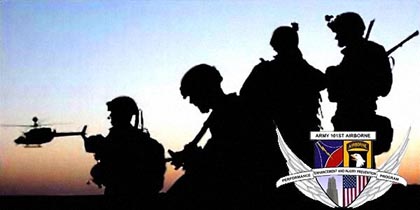UPitt Warrior Human Performance Research
The University of Pittsburgh's Department of Defense Injury Prevention and Performance Optimization Research
Projects:
101st Airborne (Air Assault) | NSW Group2 (SEALs)
NSW Group4 (SWCC) | NSW SQT / CQT | USASOC
Newsletters:
Fall 2011 | Spring 2011 | Spring 2010 | Spring 2009 | Fall 2008
US Army 101st Airborne (Air Assault)
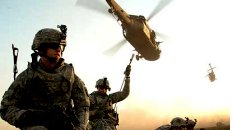 The Department of Defense Injury Prevention and Performance Optimization Research Initiative began in 2006 with the US Army 101st Airborne (Air Assault) Division at Fort Campbell, KY. The NMRL has been able to identify sub-optimal characteristics by identifying injury patterns and conducting laboratory tests to measure musculoskeletal, physiological, and nutritional aspects of the soldiers. Using this information and considering the tactical demands of the soldiers the Eagle Tactical Athlete Program (ETAP). ETAP has since replaced the traditional physical training activities for the Division. Division-wide implementation of ETAP began in May 2009 utilizing the "Train the Trainer" strategy. The ETAP implementation utilizes an Instructor Certification School (ICS), which is a 4-day school designed to teach Non-Commissioned Officers (NCOs) how to implement ETAP with their respective units. A systematic approach has been implemented to monitor daily training exposure, track injuries, and monitor performance adaptations with the research objective to evaluate the effects of ETAP on reducing unintentional musculoskeletal injuries.
The Department of Defense Injury Prevention and Performance Optimization Research Initiative began in 2006 with the US Army 101st Airborne (Air Assault) Division at Fort Campbell, KY. The NMRL has been able to identify sub-optimal characteristics by identifying injury patterns and conducting laboratory tests to measure musculoskeletal, physiological, and nutritional aspects of the soldiers. Using this information and considering the tactical demands of the soldiers the Eagle Tactical Athlete Program (ETAP). ETAP has since replaced the traditional physical training activities for the Division. Division-wide implementation of ETAP began in May 2009 utilizing the "Train the Trainer" strategy. The ETAP implementation utilizes an Instructor Certification School (ICS), which is a 4-day school designed to teach Non-Commissioned Officers (NCOs) how to implement ETAP with their respective units. A systematic approach has been implemented to monitor daily training exposure, track injuries, and monitor performance adaptations with the research objective to evaluate the effects of ETAP on reducing unintentional musculoskeletal injuries.
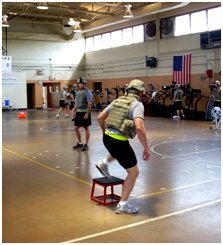 Continued research with the 101st Airborne (Air Assault) at Fort Campbell, KY will include further ETAP implementation and injury surveillance, monitoring longitudinal effects of ETAP, and redeployment testing. Future projects at Fort Campbell, KY will include a weight management and performance optimization intervention for the 101st Airborne (Air Assault). The Weight Management/Performance Optimization Intervention project will address the specific nutritional needs of the overweight 101st Soldier with a comprehensive weight management and performance optimization intervention. The intervention will include innovative feeding strategies that merge weight management techniques, including motivational interviewing/counseling, and nutrition and dietary supplement education for the Soldier and their family.
Continued research with the 101st Airborne (Air Assault) at Fort Campbell, KY will include further ETAP implementation and injury surveillance, monitoring longitudinal effects of ETAP, and redeployment testing. Future projects at Fort Campbell, KY will include a weight management and performance optimization intervention for the 101st Airborne (Air Assault). The Weight Management/Performance Optimization Intervention project will address the specific nutritional needs of the overweight 101st Soldier with a comprehensive weight management and performance optimization intervention. The intervention will include innovative feeding strategies that merge weight management techniques, including motivational interviewing/counseling, and nutrition and dietary supplement education for the Soldier and their family.
Funding for the Fort Campbell project has been provided by USAAMRE/TATRC #W81XWH-06-2-0070/W81XWH-09-2-0095.
NSW Group2, SEALs
 US Navy SEALs are a principle special operations force and the maritime component of the United States Special Operations Command. Naval Special Warfare Group 2(NSWG2) is the East Coast group of SEAL teams.
US Navy SEALs are a principle special operations force and the maritime component of the United States Special Operations Command. Naval Special Warfare Group 2(NSWG2) is the East Coast group of SEAL teams.
Research was designed to scientifically address the current injury prevalence of NSWG2 Operators and identify modifiable contributors to injury and optimal physical readiness. A total of 302 Operators were enrolled and underwent a comprehensive human performance assessment for injury prevention and optimal physical readiness to evaluate biomechanical, musculoskeletal, physiological, and nutritional characteristics relative to injury and performance.
The data collect by the NMRL were provided to NSWG2’s Tactical Athlete Program (TAP) personnel for modification and current training. The current proposal will identify specific risk factors for unintentional musculoskeletal injuries; validate the effectiveness of NSWG2’s TAP and training to improve the suboptimal SEAL-Specific characteristics that have been identified; and initiate interval testing/surveillance to assess operational drain, reference following injury, and effectiveness of TAP to improve physical readiness.
Funding for the Naval Special Warfare Group 2 project has been provided by ONR Awards #N00014071190 / N000140810412 / N000141110929.
NSW Group 4, Special Boat Team 22
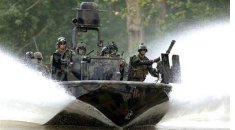 The Special Warfare Combatant-Craft Crewmen (SWCC)) is one of the elite combat units of Naval Special Warfare and specializes in the operation of rapid mobility in shallow water where larger ships cannot operate. Modeled after our research with Naval Special Warfare Group 2, this project aims to identify injury risk factors that are culturally-specific to the SWCC.
The Special Warfare Combatant-Craft Crewmen (SWCC)) is one of the elite combat units of Naval Special Warfare and specializes in the operation of rapid mobility in shallow water where larger ships cannot operate. Modeled after our research with Naval Special Warfare Group 2, this project aims to identify injury risk factors that are culturally-specific to the SWCC.
The NSW Group 4 project has established an injury prevention and human performance research laboratory at Stennis Space Center, Stennis, MS. Our current research operations include testing the specific task and demands of the SWCC and identifying the biomechanical, musculoskeletal, physiological, and nutritional characteristics which contribute to injury and inhibit optimal performance.
Research activities at Stennis Space Center are currently ongoing with Phases 1 and 2. The Operators at NSWG4/SBT22 are tactically different than NSWG2 and testing will demonstrate culturally-specific injury patterns, and suboptimal characteristics relative to injury and optimal tactical readiness. Anecdotal evidence provided by NSWG4/SBT22 medical command identified a distribution of injuries to SWCC. The data from the current proposal will be provided to NSWG4/SBT22’s Tactical Athlete Program (TAP) personnel to incorporate into current training. The modified TAP program will then be validated to improve the previously identified suboptimal SWCC-specific characteristics.
Funding for the Naval Special Warfare Group 4 project has been provided by ONR Awards #N000140810412 / N000141110929.
NSW SQT / CQT
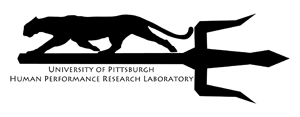 SEAL Qualification Training/Crewman Qualification Training (SQT/CQT) is the final phase of training to become a SEAL/SWCC. However, little data exists to identify the physical and physiological characteristics of SEALS/SWCC at the beginning of their career and the potential for long-term injury and suboptimal performance. The research with SQT/CQT will be collected at the Human Performance Research Laboratory located in Coronado, CA in order to:
SEAL Qualification Training/Crewman Qualification Training (SQT/CQT) is the final phase of training to become a SEAL/SWCC. However, little data exists to identify the physical and physiological characteristics of SEALS/SWCC at the beginning of their career and the potential for long-term injury and suboptimal performance. The research with SQT/CQT will be collected at the Human Performance Research Laboratory located in Coronado, CA in order to:
-Identify suboptimal characteristics and risk factors for injury in SEALS/SWCC prior to Group/Team assignment
-Establish baseline data for Force-wide interval testing to assess career decrement and injury prevalence, reference following injury, and effectiveness of TAP to improve physical readiness
-Assess tactical readiness
Overall, this will establish the baseline characteristics for SEAL and SWCC Operators upon entry into the force that will allow for tracking of injury, risk factors for injury, tactical readiness, and effectiveness of TAP. Laboratory and tactical testing will be performed on 300 SEAL/SWCC Operators upon completion of SQT/CQT to identify baseline data for integration into interval testing at Little Creek, VA and Stennis and establish risk factors for SQT/CQT graduates.
Funding for the Naval Special Warfare SQT / CQT project has been provided by ONR Award # N000141110929
United States Army Special Operations Command
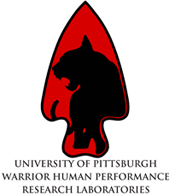 At the request of the Command Surgeon from the United States Army Special Operations Command (USASOC), this research proposal will support development of USASOC's Tactical Human Optimization, Rapid Rehabilitation, and Reconditioning (THOR3) program to identify the priorities necessary for enhancement and change in the current physical training program. The Human Performance Research Laboratory will be established at Fort Bragg, NC for this project in 2012. The overall objective of this research project is to scientifically develop an injury prevention and performance optimization program that is culturally specific and dynamically responsive to the unique tactical demands of the Special Forces soldier. This project will ultimately result in enhanced mission readiness and effectiveness, decreased time lost due to disability, personnel attrition, and financial burden associated with medical expenses and disability compensation. This research approach includes Special Forces-specific task and demand analyses to identify the operational and training-related tasks during which musculoskeletal injuries occur, laboratory tests designed to determine suboptimal parameters that increase the risk of training and tactical injuries while reducing the capacity for peak operating efficiency, and nutritional interventions to optimize physical readiness and wellness. The initiative with USASOC is funded by a $2.8 million grant from USAMRMC and TATRC.
At the request of the Command Surgeon from the United States Army Special Operations Command (USASOC), this research proposal will support development of USASOC's Tactical Human Optimization, Rapid Rehabilitation, and Reconditioning (THOR3) program to identify the priorities necessary for enhancement and change in the current physical training program. The Human Performance Research Laboratory will be established at Fort Bragg, NC for this project in 2012. The overall objective of this research project is to scientifically develop an injury prevention and performance optimization program that is culturally specific and dynamically responsive to the unique tactical demands of the Special Forces soldier. This project will ultimately result in enhanced mission readiness and effectiveness, decreased time lost due to disability, personnel attrition, and financial burden associated with medical expenses and disability compensation. This research approach includes Special Forces-specific task and demand analyses to identify the operational and training-related tasks during which musculoskeletal injuries occur, laboratory tests designed to determine suboptimal parameters that increase the risk of training and tactical injuries while reducing the capacity for peak operating efficiency, and nutritional interventions to optimize physical readiness and wellness. The initiative with USASOC is funded by a $2.8 million grant from USAMRMC and TATRC.
Funding for this project is provided by research grant USAAMRE/TATRC #W81XWH-11-2-0020. Opinions, interpretations, conclusions, and recommendations are those of the author and not necessarily endorsed by the US Army.
